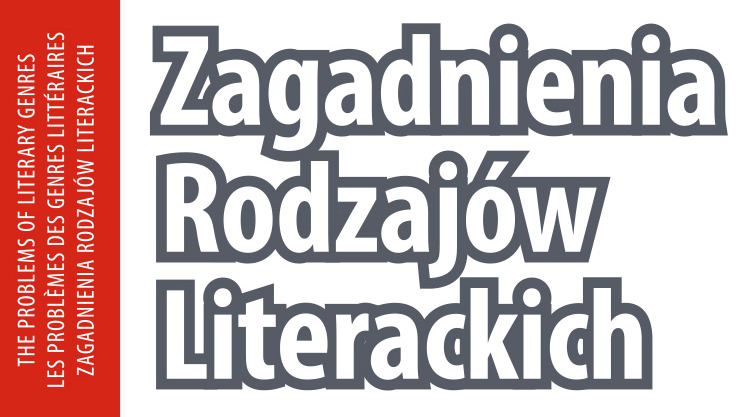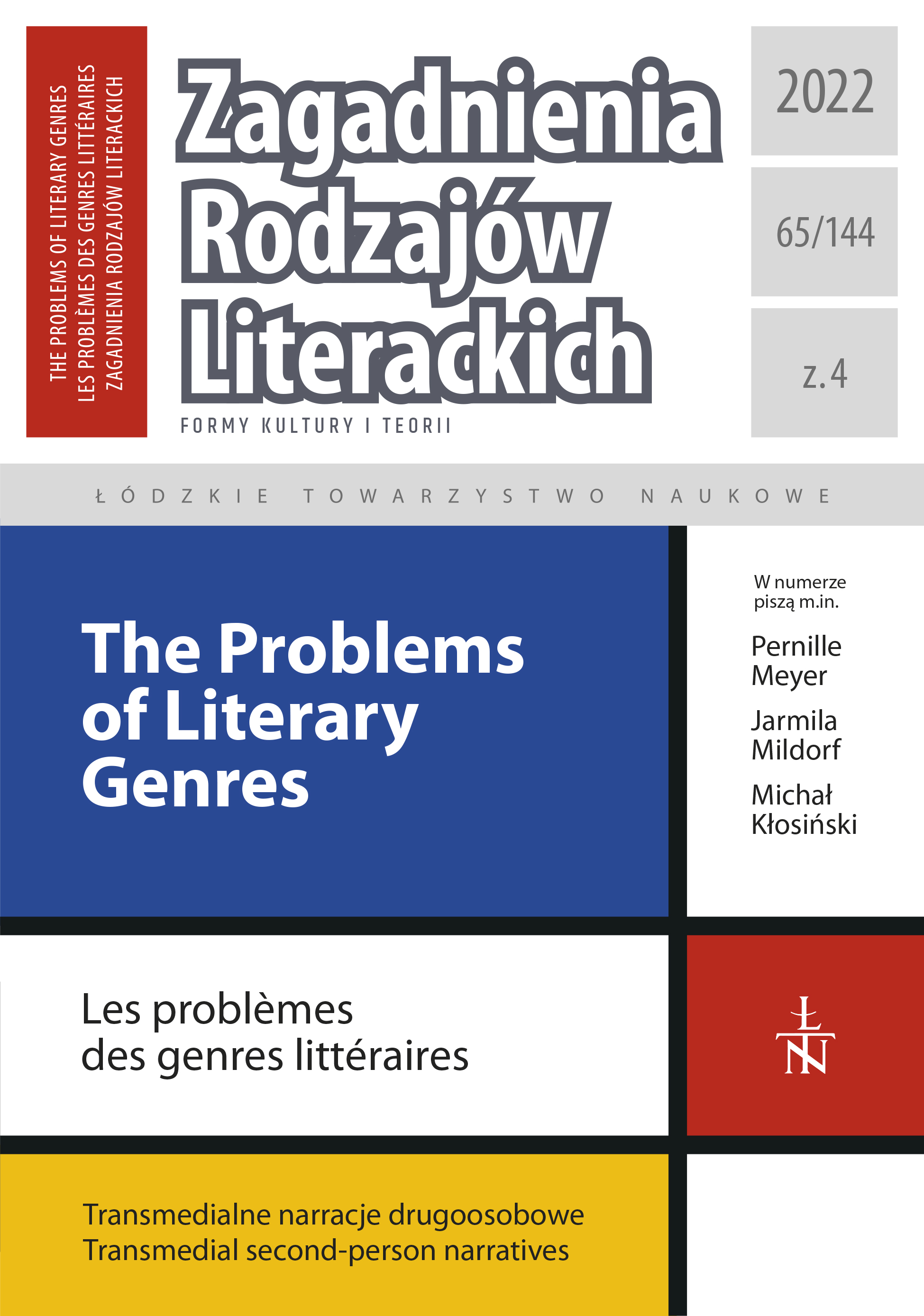Second Person in Different Genres and Cultural Practices
DOI:
https://doi.org/10.26485/ZRL/2022/65.4/1Słowa kluczowe:
second-person narrative, “you” address, narrative theory, game studiesAbstrakt
The editorial introduction shows the richness of traditional literary genres (fictional and non-fictional), new cultural practices (digital literature, games, and playable media) in which second-person address may be encountered. The presence of a direct address to “you” (individual or collective) is also a distinct marker of contemporary marketing, advertising, and social media communication. There is a number of transitional forms in-between print and digital literature and games, in which the presence of the second-person pronoun is one of the main features of poetics. These include narrative role-playing games (RPGs), game books, interactive text games, and paragraph games/books. Complementing the existing gap in Polish interdisciplinary research, the editors discuss both the historical forms of second-person narrative and its potential to cross the boundaries between various media. Additionally, the article reconstructs the fuzzy status of you-narrative in 20th-century narrative theory, since the semantic ambiguities of the multifaceted “you” address resulted in multiple theoretical attempts at defying and analyzing the second-person storytelling. We summarize the main threads of the heated debate on the semantics, poetics, and pragmatics of second-person narrative that took place at the turn of the 20th and 21st centuries. The editorial discusses the reasons why narrative theory gradually recognized the typological equivalence of second-person storytelling to the third- and first-person narrative mode. Another recurring problem in research on second person is its impact on reader’s immersion and identification processes. Moreover, we indicate the new cultural context (the digital revolution) as an important factor in the current dissemination and popularization of second-person narratives.
Liczba pobrań
Bibliografia
Alber Jan, Iversen Stefan, Nielsen Henrik Skov, Richardson Brian (2010), Unnatural Narratives, Unnatural Narratology: Beyond Mimetic Models, “Narrative” 18, no. 2.
Bell Alice, Ensslin Astrid (2011), “I Know What It Was. You Know What It Was”: Second-Person Narration in Hypertext Fiction, “Narrative” 19, no. 3.
Bell Alice, Ensslin Astrid (2021), It is All About You [in:] Digital Fiction and the Unnatural, eds. A. Bell, A. Ensslin, Ohio State University Press, Columbus.
Bogusławski Andrzej, Herman Ewa (1991), Prawda o sobie („ty” i narracja drugoosobowa”), Posługiwanie się znakami, eds. S. Żółkiewski, M. Hopfinger, Zakład Narodowy im. Ossolińskich, Wrocław.
Bonheim Helmut (1983), Narration in the Second-Person, “Recherches Anglaises et Américaines” vol. 16.
Butor Michel (1965), The Second Case. Use of Personal Pronouns in the Novel, “New Left Review” vol. 34, no. 1.
DelConte Matt (2003), Why You Can’t Speak: Second-Person Narration, Voice, and a New Model for Understanding Narrative, “Style” vol. 37, iss. 2.
Fludernik Monika (1993), Second-Person Fiction: Narrative You as Address and/or Protagonist, “Arbeiten aus Anglistik und Amerikanistik” vol. 18, no. 2.
Fludernik Monika (1994a), Second-Person Narrative as a Test Case for Narratology: The Limits of Realism, “Style” vol. 28, is. 3.
Fludernik Monika (1994b), Second-Person Narrative and Related Issues, “Style” vol. 28, no. 3.
Fludernik Monika (1994c), Second-Person Narrative: A Bibliography, “Style” vol. 28, no. 4.
Fludernik Monika (1996), Towards a “Natural” Narratology, Routledge, London.
Fludernik Monika (2011), The Category of ‘Person’ in Fiction: You and We Narrative Multiplicity and Indeterminacy of Reference [in:] Current Trends in Narratology, ed. G. Olson, De Gruy¬ter, Berlin.
Gajewski Krzysztof (2020), Tryumf amatora. O społecznościowych praktykach tekstualnych w świecie mediów elektronicznych, Wydawnictwo Uniwersytetu Warszawskiego, Warszawa.
Genette Gérard (1983), Nouveau discours du récit, Seuil, Paris.
Genette Gérard (2004), Métalepse. De la figure à la fiction, Seuil, Paris.
Górska-Olesińska Monika, Przybyszewska Agnieszka (2020), O „wypożyczaniu” ciał odbiorców na potrzeby (nie tylko) literackich immersyjnych wędrówek po przestrzeniach pamięci, „Przegląd Kulturoznawczy” no. 2.
Herman David (1994), Textual You and Double Deixis in Edna O’Brien’s A Pagan Place, “Style” vol. 28, iss. 3.
Iliopoulou Evgenia (2019), Because of You: Understanding Second-Person Storytelling, transcript Verlag, Bielefeld.
Jeziorska-Haładyj Joanna (2018) Second-Person Narratives in Non-Fiction, “Prace Filologiczne” vol. 8, no. 11.
Kacandes Irene (2001), Talk Fiction: Literature and the Talk Explosion, University of Nebraska Press, Lincoln.
Katherine Hayles (2007), Electronic Literature: What is it? Electronic Literature Organization, www.eliterature.org/pad/elp.html#sec2 [access: 8.12.2022].
Macrae Andrea (2016), You and I, Past and Present. Cognitive Processing of Perspective, “Diegesis” vol. 5, no. 1.
Marcus Amit (2008), A Contextual View of Narrative Fiction in the First Person Plural, “Narrative” vol. 16, no. 1.
Margolin Uri (1990), Narrative ‘You’ Revisited, “Language and Style” vol. 23.
Mildorf Jarmila, (2016), Second-Person Narration and Involvement, “Language and Literature” vol. 25.
Mildorf, Jarmila (2012), Second-Person Narration in Literary and Conversational Storytelling, “Storyworlds: A Journal of Narrative Studies” vol. 4.
Morrissette Bruce (1965), Narrative ‘You’ in Contemporary Literature, “Comparative Literature Studies” vol. 2.
Parker Joshua (2012), In Their Own Words: On Writing in Second-Person, “Connotations” vol. 21.
Reitan Rolf (2011), Theorizing Second-Person Narratives: A Backwater Project? [in:] Strange Voices in Narrative Fiction, eds. Per Krogh Hansen et al., De Gruyter, Berlin.
Rembowska-Płuciennik Magdalena (2022), Enactive, Interactive, Social — New Contexts for Reading Second-Person Narration, “Narrative” vol. 30, no. 1.
Rembowska-Płuciennik Magdalena (2018), Second-Person Narration as Joint Action, “Language and Literature” vol. 27, iss. 3.
Richardson Brian (1991), The Poetics and Politics of Second-Person Narrative, “Genre” 24(3).
Richardson Brian (2006), Unnatural Voices: Extreme Narration in Modern and Contemporary Fiction, Ohio State University Press, Columbus.
Role-Playing Game Studies (2018), eds. Sarah Hoover at al., Routledge, London.
Ryan Marie-Laure (2002), Narrative as Virtual Reality. Immersion and Interactivity in Literature and Electronic Media, Johns Hopkins University Press, Baltimore.
Second Person. Role-Playing and Story in Games and Playable Media (2010), eds. P. Harrigan, N. Wardrip-Fruin, MIT Press, Cambridge.
Sorlin Sandrine (2022), The Stylistics of You. The Second-Person Pronoun and its Pragmatic Effects, Cambridge University Press, Cambridge.
Szeja Jerzy Z. (2004), Gry fabularne. Nowe zjawisko kultury współczesnej, Rabid, Kraków.
The Pragmatics of Personal Pronoun (2015), eds. G. Laure, S. Sorlin, John Benjamins, Amsterdam.
The Second Person: Philosophical and Psychological Perspectives (2016), ed. N. Eilan, Routledge, New York.
van Dijk José (2013), The Culture of Connectivity: A Critical History of Social Media, Oxford University Press, Oxford.
Walker Jill (2002), ‘Do you think you’re part of this? Digital texts and the second-person address’ [in:] Cybertext Yerbook 2000, eds. R. Koskimaa, M. Eskelinen, University of Jyväskylä, Jyväskylä.








